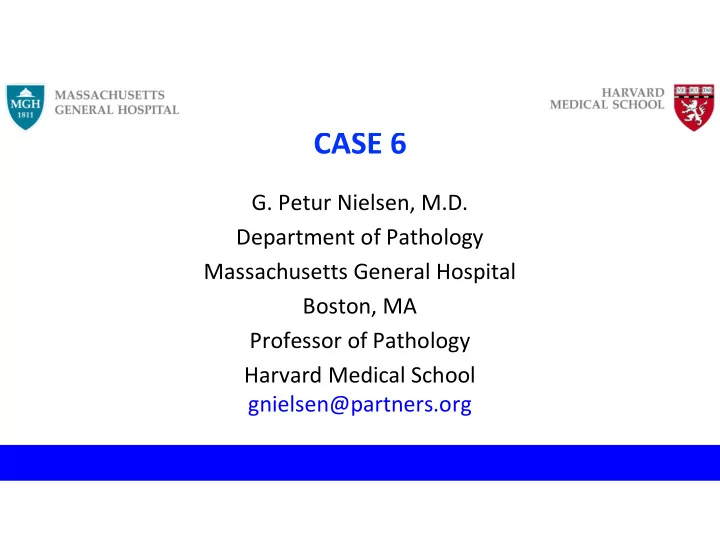

CASE 6 G. Petur Nielsen, M.D. Department of Pathology Massachusetts General Hospital Boston, MA Professor of Pathology Harvard Medical School gnielsen@partners.org
CASE 6 43 year old presented with pain in the right upper thigh that had recently increased. There was a history of minor trauma and injury in the remote past
Diagnosis Bizarre parosteal osteochondromatous proliferation (BPOP)
BPOP First described by Nora et al. 35 patients 14‐74 years old 0.4‐3 cm Proximal phalanges / metatarsals / metacarpals 18 local recurrence – 8 locally recurred twice Nora et al. Bizarre parosteal osteochondromatous proliferations of the hands and feet. Am J Surg Pathol 1983; 7:245‐250
BPOP 65 patients 8‐73 years old 72% involved the small bones 27% involved long bones 14 with one local recurrence – 5 with two – 3 with three Menses et al. Bizarre parosteal osteochondromatous proliferations of bone (Nora’s lesion). Am J Surg Pathol 1993; 17:691‐697
Fibrous tissue Cartilage Bone
BPOP Initially thought to be a non‐neoplastic, reactive process t(1;17(q32;q21) has been identified supporting a neoplastic process Four cases with inversion of chromosome 7 have been described Nilsson et al et al. Molecular cytogenetic characterization of recurrent translocation breakpoints in bizarre parosteal osteochondromatous proliferation (Nora’s lesion). Human Pathology 2004;35:1063‐1069 Endo et al. Bizarre parosteal osteochondromatous proliferation with a t(1;17) translocation. Virchows Archiv 2005;447:99‐102 Broehm et al. Bizarre parosteal osteochondromatous proliferation: a new cytogenetic subgroup characterized by inversion of chromosome 7. Cancer Genetics 2013;206:402‐405
BPOP – Differential Diagnosis Small bones Subungual exostosis Florid reactive periostitis
Subungual Exostosis Location of Subungual Exostosis Based on 244 Cases Arises in a subungual 13% location 10% t(X;6)(q24‐26;q15‐21) 77% Great Toe Other Toes Fingers • DaCambra et al. Subungual Exostosis of the Toes: A Systematic Review. Clin Orthop Relat Res 2014;472:1251‐1259 • Mertens et al. The t(X;6) in subungual exostosis results in transcriptional deregulation of the gene for insulin receptor substrate 4. Int. J. Cancer 2011;128:487‐491
Florid Reactive Periostitis Surface lesion of small bones of hands and feet (parosteal fasciitis – unusual myositis ossificans) Probably reactive / traumatic process – no genetic abnormality has been identified Spjut et al. Florid reactive periostitis of the tubular bones of the hands and feet. A benign lesion which may simulate osteosarcoma. Am J Surg Pathol 1981;5:423‐433
BPOP – Differential Diagnosis Long bones Parosteal osteosarcoma Periosteal osteosarcoma Osteochondroma
Parosteal Osteosarcoma
Parosteal Osteosarcoma
Parosteal Osteosarcoma
Periosteal Osteosarcoma
Periosteal Osteosarcoma
Osteochondroma
Osteochondroma
Osteochondroma
CASE 6 Treated with resection No recurrence 11 years later
Thank You
Recommend
More recommend